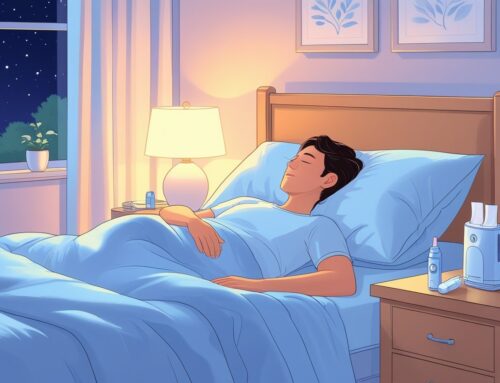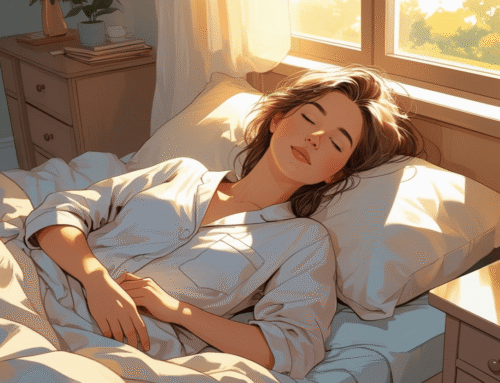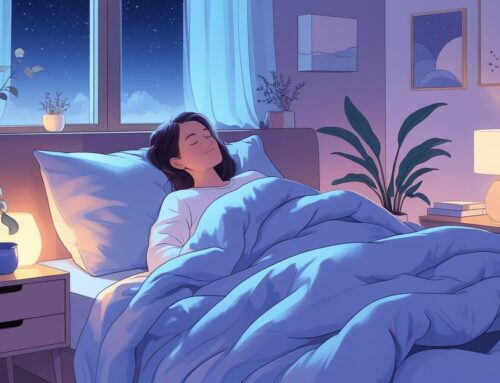Sleeping with a herniated disc is difficult because of pain and discomfort that interrupt rest. The most effective way to sleep is on your back or side while keeping the spine properly supported. This helps maintain its natural curve and reduces pressure on the affected disc. Positioning pillows in the right spots can ease tension and keep the spine aligned through the night.
It’s best to avoid sleeping on your stomach since it tends to twist the spine and make the pain worse. Instead, place a pillow between the knees when lying on your side, or under the knees when lying on your back. These simple changes can ease discomfort and support better and more restful sleep, giving the body a chance to recover.
Key Takeaways
- Good spinal alignment helps minimize pain during sleep.
- Side and back positions work best for herniated discs.
- Supportive pillows improve comfort and protect spinal health.
- The right mattress helps herniated disc pain. It keeps the spine aligned, supports the lower back, and works best when you sleep on your back with a pillow under your knees.
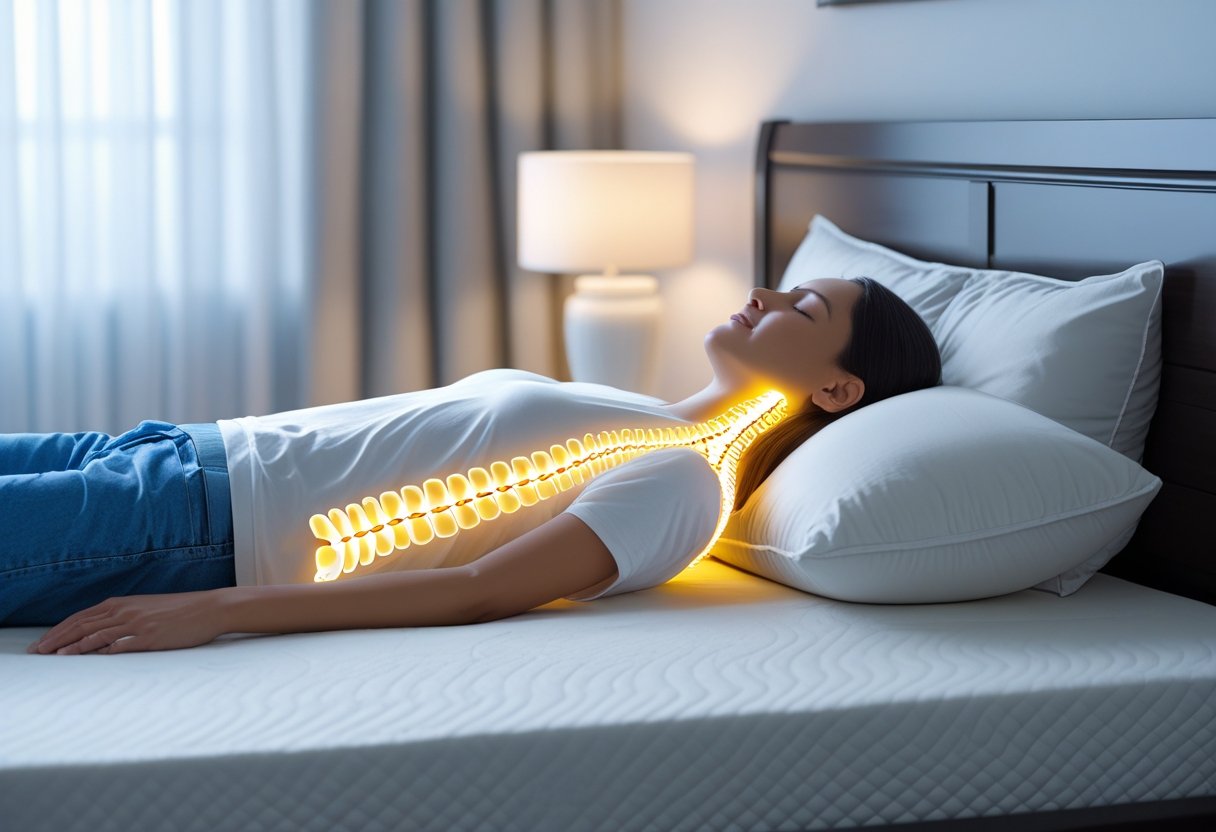
Understanding Herniated Discs and Their Impact on Sleep
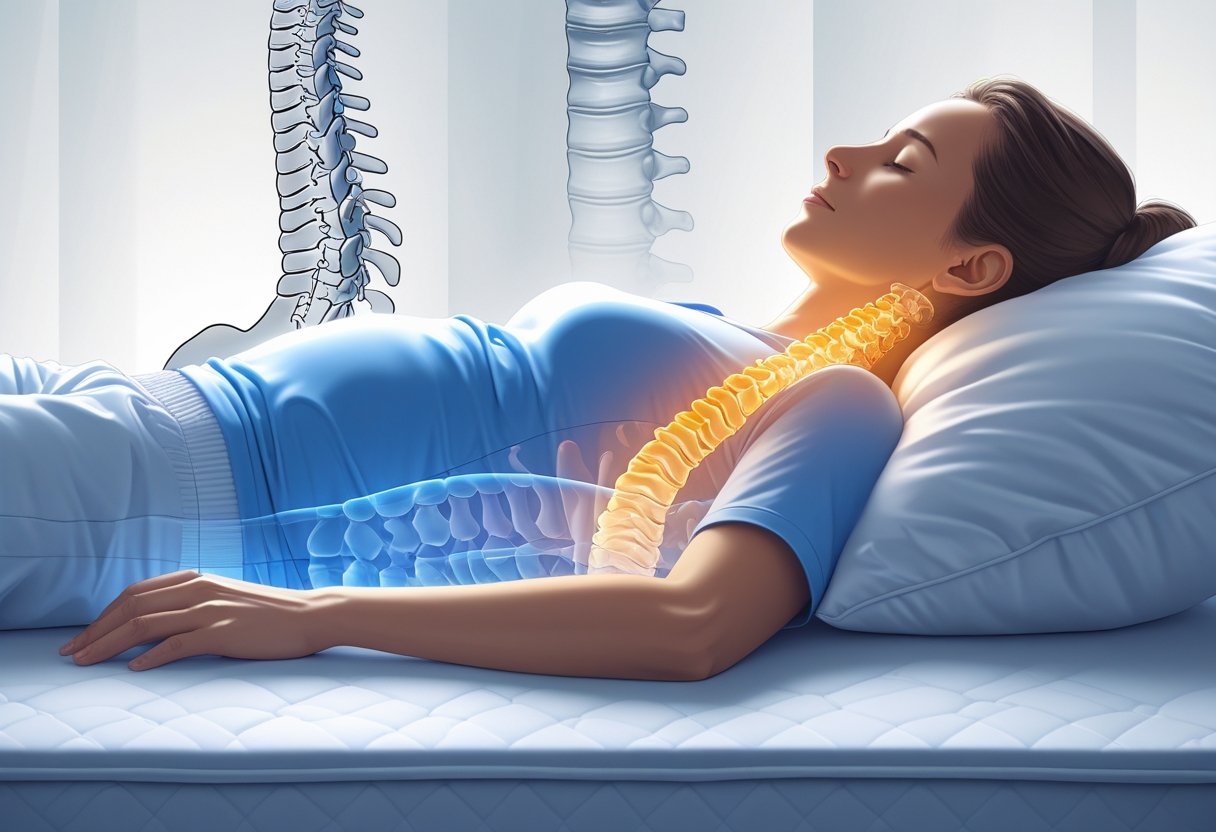
A herniated disc occurs when the soft inner part of a spinal disc pushes through its tougher outer layer. This can irritate nearby nerves and cause pain, numbness, or weakness. Pain often worsens at night, making it hard to get a good night’s sleep. Adjusting your sleep position and daily habits can help ease discomfort. Where the herniation is located affects which positions feel best. Noticing symptoms that interfere with rest can guide better choices for support and alignment.
What Is a Herniated Disc?
A herniated disc happens when the soft, gel-like center of a spinal disc pushes through its strong outer layer. This can press on nearby nerves, causing pain, tingling, or weakness.
Discs act as cushions between the bones of your spine. They absorb shocks and allow movement. Herniation can result from injury, overuse, or natural aging. Sleeping poorly usually doesn’t cause a herniation, but it can make the pain worse. Heavy lifting, sudden twisting, or repetitive strain often trigger or worsen a herniated disc. Knowing the cause helps in managing sleep and avoiding further injury.
How Disc Location Affects Sleep
Cervical (Neck)
- Symptoms: Neck pain, arm numbness, or weakness
- Sleep issues: Finding a pillow that keeps the neck aligned without strain
Thoracic (Upper Back)
- Symptoms: Mid-back pain; less common than other areas
- Sleep issues: Lying flat can be uncomfortable; limited mobility
Lumbar (Lower Back)
- Symptoms: Lower back pain, sciatica, leg numbness
- Sleep issues: Pressure on the lower back; may need pillow support under legs
Sacral (Base of Spine)
- Symptoms: Similar to lumbar issues, sometimes with nerve problems
- Sleep issues: Adjustments needed to ease pressure on hips and buttocks
Choosing positions like side sleeping with a pillow between the knees or back sleeping with legs slightly raised depends on which disc is affected.
Common Symptoms That Disrupt Sleep
Pain is usually the main reason sleep is interrupted. This can feel sharp, burning, or spread as tingling into the arms or legs. Other problems include muscle weakness, numbness, or pins-and-needles sensations. These often cause tossing, turning, or waking up during the night. Inflammation around the disc can affect nerves that help regulate sleep, making it hard to fall or stay asleep.
Frequent nighttime complaints include:
- Sharp pain when moving
- Stiffness after lying down
- Trouble settling into a comfortable position
Managing these issues involves finding supportive positions and arranging your bed to reduce pressure and keep the spine stable.
Best Sleeping Positions for Herniated Disc Pain Relief
Finding the right sleep position can relieve spinal pressure and ease herniated disc pain. Some positions naturally support spinal curvature and help prevent nerve compression. With proper pillow placement and posture, sleep comfort and quality can improve.
Side Sleeping With a Pillow Between Knees
Sleeping on your side often helps people with herniated disc pain. It keeps the spine aligned and lowers disc pressure. Placing a firm pillow between your knees keeps your hips level and stops your lower back from twisting. The pillow fills the gap between your legs and reduces strain on your hips and lower back. You can try different pillow thicknesses to see what feels best. A memory foam or contoured pillow can adjust to your body and give extra support.
Fetal Position for Spinal Decompression
Curling up in a fetal position can create space between the vertebrae and ease nerve pressure. Pulling your knees slightly toward your chest gently flexes the spine, which may relieve lower back disc pain. Use a pillow that keeps your head in line with your spine to avoid neck strain. Don’t curl too tightly, since that can put pressure on your chest and stomach. A loose, relaxed fetal position offers a good balance of comfort and decompression.
Supine With Knee Support
Lying on your back with your knees slightly raised can reduce pressure on herniated discs. Raising your knees flattens the curve in your lower back and eases tension in that area. A small pillow or rolled towel under the knees helps hold the position and spreads weight evenly. This prevents twisting or bending that could make disc pain worse. People with lower spine disc problems often find this position helpful.
Reclined Sleeping for Improved Comfort
A reclined posture, using a reclining chair or adjustable bed, can help lower disc pressure. It supports the spine in a semi-upright position, which redistributes weight and reduces strain on the lower back. This approach may work best for individuals with severe lumbar herniated discs or sciatica. Lumbar cushions help maintain spinal curvature. Reclined sleeping also reduces muscle tension and allows the body to relax more fully.
If unsure about reclined options, consider consulting a healthcare provider about adjustable beds or chairs designed for back support.
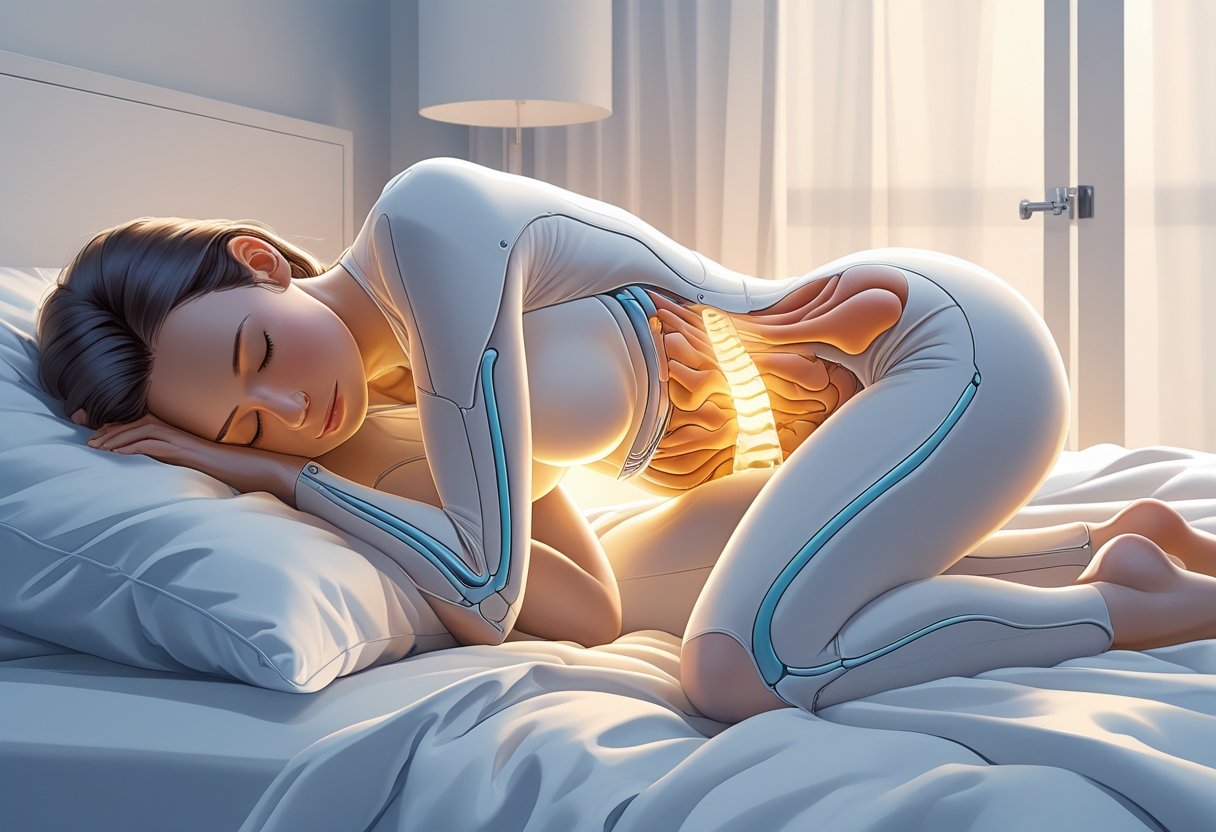
How to Sleep With a Herniated Disc in Different Spine Regions
Sleeping with a herniated disc depends on which part of the spine is affected. Support and positioning differ based on whether the issue involves the neck, upper back, or lower back. The right sleep posture helps ease pain and reduce nerve pressure.
Cervical Disc Herniation (Neck)
When herniation affects the neck, particularly at C5-C6 or C6-C7, sleeping position plays a key role in preventing symptoms like neck pain, tingling, or arm weakness.
Sleeping on the back with a thin or cervical pillow works best. This type of pillow supports the neck’s natural curve and keeps it aligned with the spine. A rolled towel placed under the neck can also maintain proper posture. Side sleeping is another option, but the pillow must fill the space between the neck and mattress to avoid awkward bending. Avoid sleeping on the stomach, as it forces the neck into unnatural extension.
Keeping the neck supported and aligned with the spine helps relieve pressure from herniated discs in this region.
Thoracic Disc Herniation (Upper Back)
Herniated discs in the thoracic spine are less common but may cause mid-back pain or tightness. Since the rib cage provides support here, alignment during sleep is essential.
Back sleeping on a firm mattress offers even support for the spine. A pillow placed under the knees keeps the spine neutral and relieves strain on the upper back. Side sleeping works if a pillow goes between the knees and another rests along the torso to prevent spinal twisting. Avoid stomach sleeping, which can strain the thoracic spine and worsen pain. A straight, supported spine reduces discomfort in this area.
Lumbar Disc Herniation (Lower Back)
The lower back, especially at L4-L5 or L5-S1, is the most common site for herniated discs. Pain often extends into the legs and affects movement, making sleep posture especially important.
Sleeping on the back with a pillow under the knees helps relieve lower back pressure. A rolled towel under the lumbar curve offers added support. Side sleeping with a pillow between the knees aligns the hips, pelvis, and spine to ease disc pressure. Stomach sleeping places too much stress on the lower back and should be avoided. If necessary, placing a pillow under the hips may help reduce tension.
These adjustments aim to keep the spine aligned and lessen nerve irritation during sleep. For ongoing pain, consult a healthcare provider.
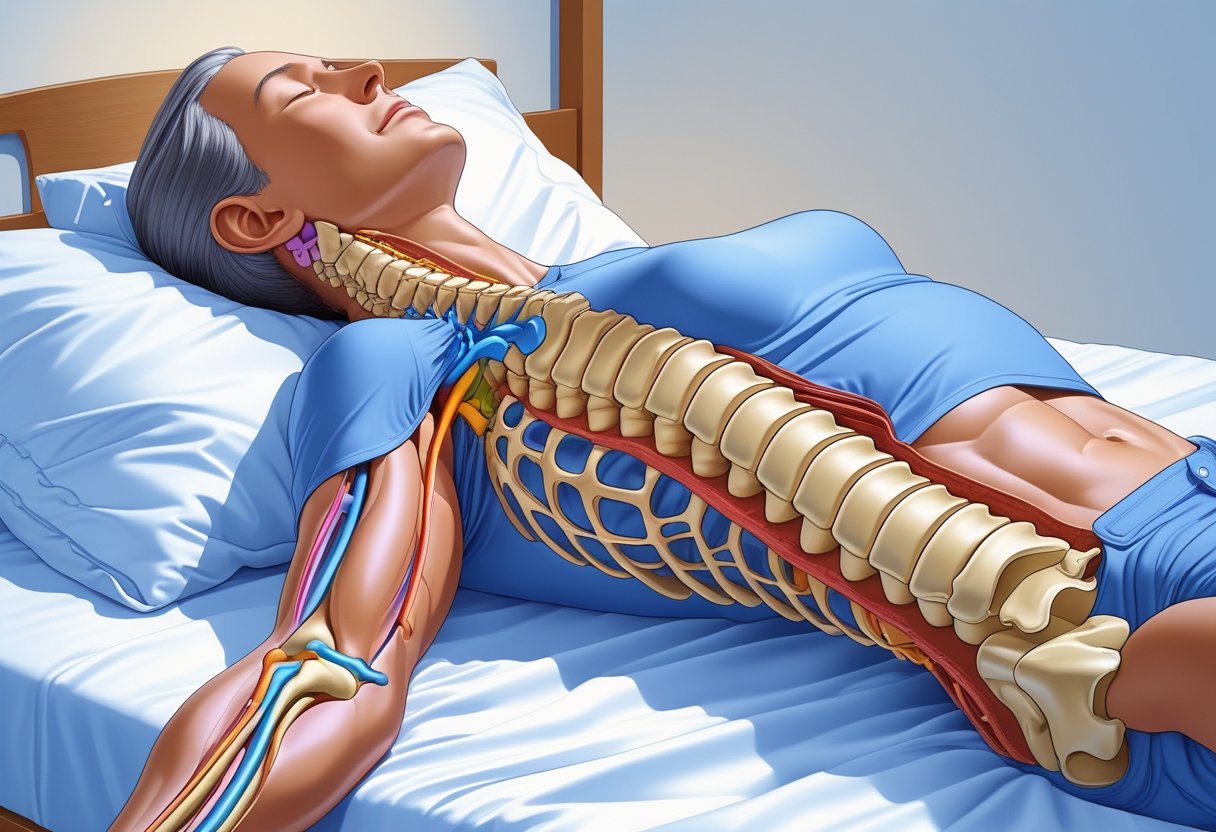
Optimizing Your Sleep Environment
A good sleep environment promotes proper spinal alignment and relieves pressure on herniated discs. Focusing on mattress firmness, pillow choice, and room conditions can ease pain and improve rest. Even those who choose to sleep on the floor need to make sure the setup doesn’t add strain.
Choosing a Supportive Mattress
A medium-firm mattress usually offers the best mix of comfort and support for herniated discs. It keeps the spine aligned and prevents the body from sinking too much, which can put pressure on sore areas. Memory foam and hybrid mattresses are helpful because they contour to your body and spread your weight evenly.
Sleeping on the floor might seem firm enough, but it can cause uneven pressure without proper cushioning. A thin mattress or supportive mat can help absorb pressure while keeping the body from sinking. Very soft or extremely firm mattresses can make pain worse. If your mattress is over 7–10 years old or has deep impressions, it’s probably time to replace it.
Selecting the Right Pillow
Head and neck support matters, especially if you have a cervical herniation. Memory foam or other contouring materials can help keep the neck in its natural curve.
Look for a pillow that:
- Fills the space between the neck and mattress
- Supports the head without pushing it forward
- Is adjustable or contoured for your comfort
Side sleepers need thicker pillows to keep the head aligned with the spine. Back sleepers should use a thinner pillow to avoid bending the neck backward. Placing a pillow between the knees can also help side sleepers maintain spinal alignment.
Room Setup for Better Rest
The room itself can affect sleep and help relieve disc pain. Keep the room cool, around 60–67°F (15.5–19.5°C), to encourage deep sleep. Block out light with curtains or an eye mask. Reduce noise using white noise machines, earplugs, or other soundproofing options. Keeping the space tidy and free of clutter also helps create a calm environment.
Pairing these elements with a supportive mattress and the right pillow creates an ideal sleep setup for managing herniated disc pain.

Lifestyle Tips and Pre-Bedtime Strategies
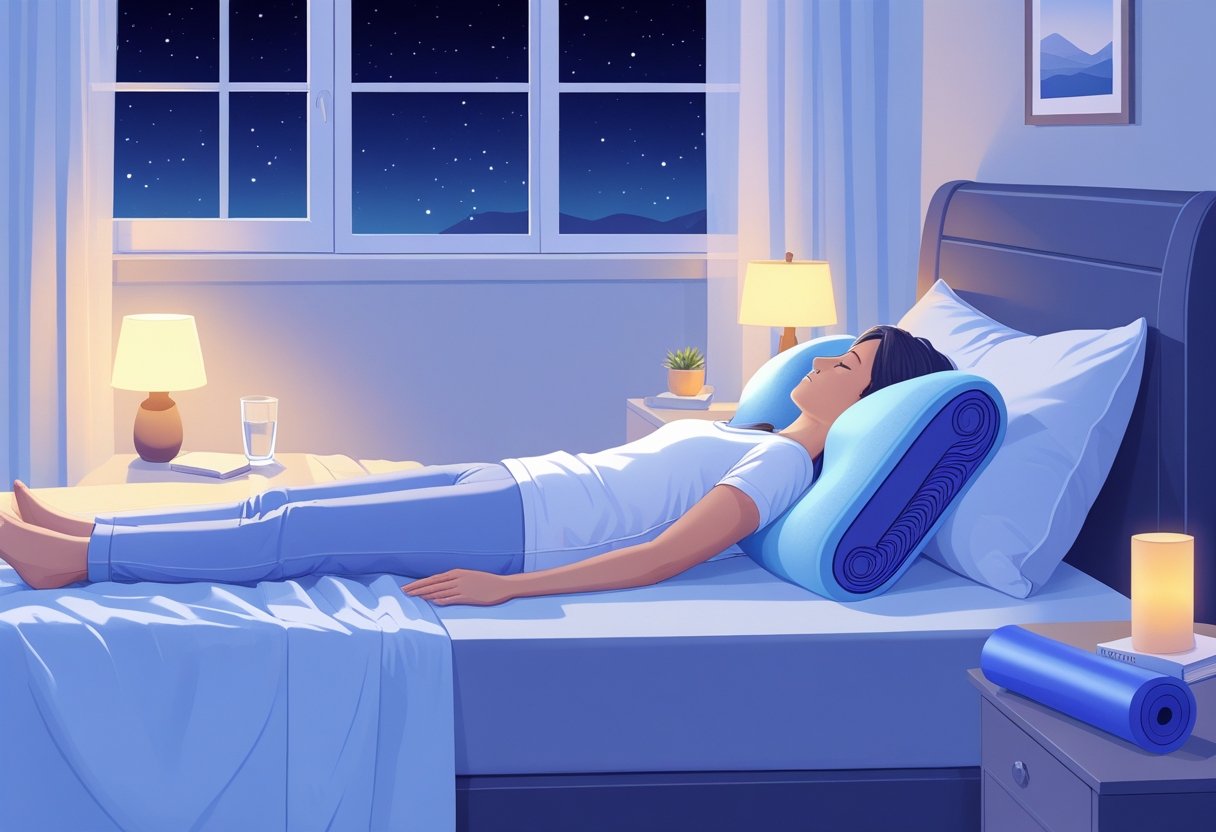
Managing herniated or bulging discs requires more than just choosing the right sleep position. Daily habits, pain control strategies, and a steady sleep routine all play a role in improving comfort and rest.
Stretching and Mobility Exercises
Gentle stretching can help loosen tight muscles that make disc pain worse. Focus on slow, controlled movements for your back, hips, and core. These areas are important for keeping your spine stable and flexible.
Exercises like knee-to-chest stretches, pelvic tilts, and cat-cow poses can reduce stiffness if done carefully and without pushing into pain. Avoid sudden or forceful movements that might irritate nerves. Doing these stretches regularly, especially before bed, can make it easier to fall asleep comfortably.
Pain Management Before Bed
Dealing with pain before lying down can help you sleep through the night. Heat, such as a warm towel or heating pad for 15–20 minutes, relaxes tight muscles and eases tension where discs are affected. Over-the-counter pain medicine like ibuprofen or acetaminophen may help, but only under a doctor’s guidance. Taking them before bed can reduce pain that might wake you up. Relaxation methods like deep breathing or short meditation can also help lower stress and make falling asleep easier.
Developing Consistent Sleep Habits
Keeping a regular sleep schedule helps your body know when it’s time to rest. Going to bed and waking up at the same time every day, even on weekends, improves sleep quality despite ongoing disc pain.
A bedtime routine signals your body it’s time to wind down. This can include dimming lights, avoiding screens, or listening to calming music. A cool, quiet, and dark bedroom also helps you sleep deeper. Avoid caffeine and heavy meals before bed to prevent discomfort. Small changes like these make it easier to rest well while managing chronic pain.
When to Seek Medical Advice About Sleep and Herniated Discs
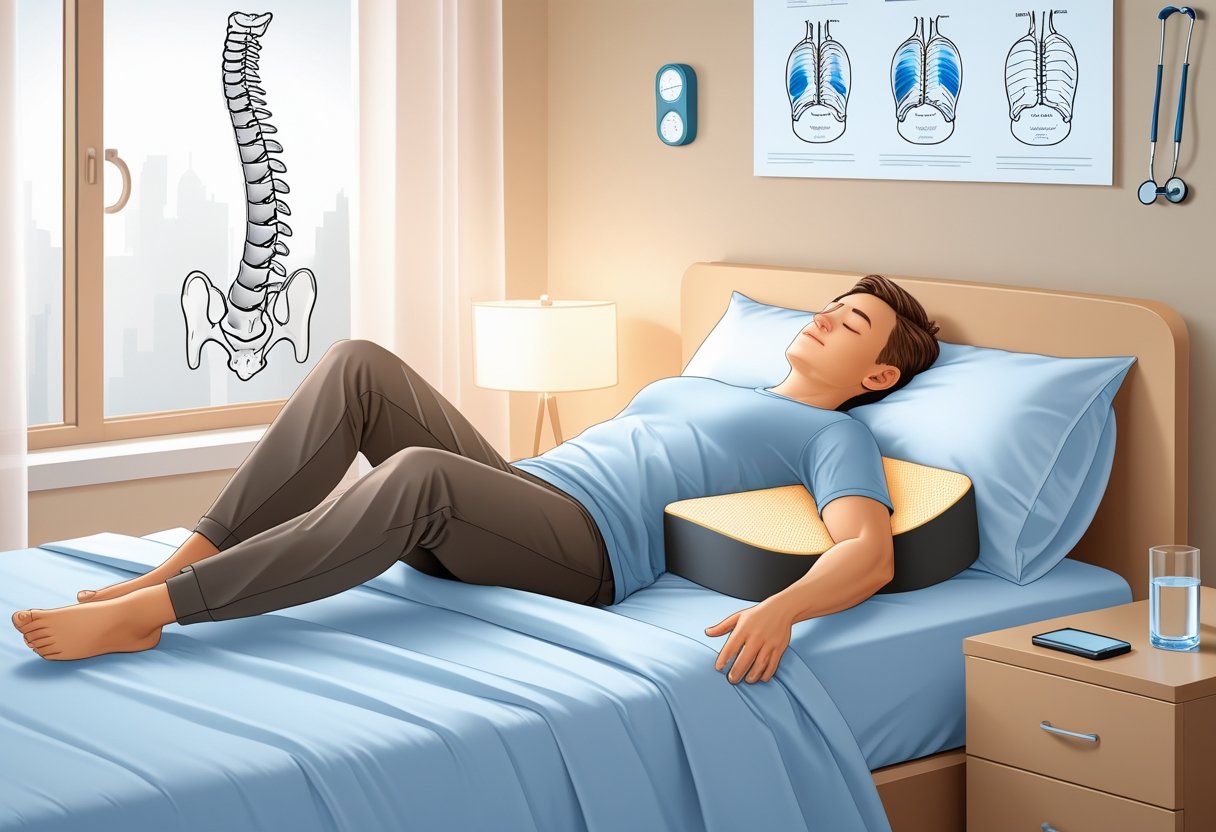
If a herniated disc causes ongoing sleep issues or persistent pain, seeking professional medical advice becomes essential. Certain signs reveal when at-home remedies fall short and when it’s time to consider expert care or non-surgical treatments. Recognizing these signs helps guide timely and effective decisions.
Recognizing Persistent Sleep Disruption
Sleep problems that last for weeks, even after changing positions, can mean the issue is more serious. Pain from a herniated disc or sciatica that regularly wakes someone or makes it hard to fall asleep is usually a sign to see a doctor.
Other warning signs include:
- Pain that gets worse at night
- Numbness or leg weakness that makes movement difficult
- Trouble staying asleep even with pillows or heat support
- Daytime fatigue or restlessness from poor sleep
These often show that home remedies like side sleeping with cushions or elevating the knees aren’t enough.
Non-Surgical Treatments and Professional Support
Many herniated discs improve with non-surgical care. Physical therapy can help sleep by teaching proper posture and strengthening muscles. Therapists often suggest exercises, stretches, and supports that ease pain at night. Doctors might also prescribe medication or suggest heat therapy. They create care plans based on symptoms and daily routines. Tracking how symptoms change helps adjust the plan without needing surgery right away.
Getting help early can make sleep easier and safer. Treatments depend on where the disc is and how bad the pain feels, so a professional plan is usually the most effective approach.
How the Right Mattress Supports Better Sleep with a Herniated Disc
The right mattress is important in reducing pain caused by a herniated disc. It supports the spine in a neutral position, preventing extra pressure on injured discs during sleep. A mattress designed for herniated discs must offer balanced support and pressure relief. A mattress that is too firm increases pressure on the back and hips. One that is too soft allows the body to sink and causes poor alignment.
Many experts recommend mattresses with:
- Good lumbar support to keep the lower back stable
- Pressure point relief to ease pain in sensitive areas
- Medium firmness to balance comfort and support
Popular mattress types for herniated discs include memory foam, latex, hybrids, and adjustable air mattresses. While each type contours to the body differently, all should maintain proper spinal alignment. For example, the Helix Midnight mattress has medium firmness with targeted lumbar support, which is great for those managing back pain.
The Helix Midnight mattress combines memory foam and responsive coils to provide both contouring comfort and reliable support. Its zoned lumbar technology supports the lower back without sacrificing pressure relief on the shoulders and hips. This balance helps maintain proper alignment and reduces the risk of tossing and turning throughout the night.
In addition, the Helix Midnight mattress features breathable materials that regulate temperature and keep sleepers cool. This enhances overall comfort, especially for those who find discomfort or disrupted sleep worsened by overheating. Its durability and thoughtful design make it a practical choice for anyone seeking relief from disc-related back pain. Sleeping on the back with a pillow under the knees reduces strain. The mattress should support this posture by filling the space under the lumbar curve.
Choosing the right mattress improves sleep quality by lessening discomfort. This helps users avoid tossing and turning, which worsens pain. It promotes a more restful night and supports better recovery.

Frequently Asked Questions
Proper sleeping and sitting positions reduce pressure on the spine and ease pain caused by a herniated disc. Adjusting pillows and body alignment plays a crucial role in maintaining spinal support and comfort throughout the night.

